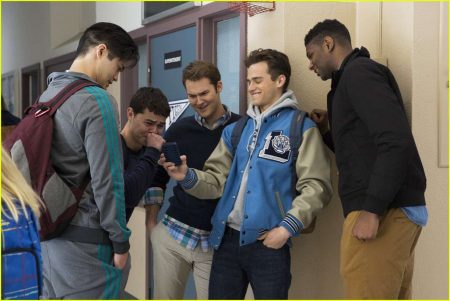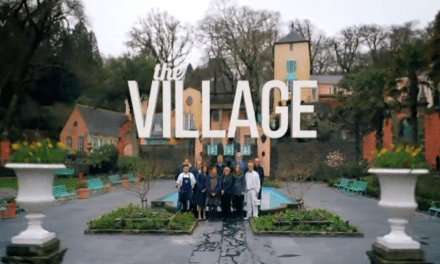** This blog contains spoilers **
Firstly, apologies – this blog contains spoilers. But seeing as 13 Reasons Why was released on Netflix in the UK several months ago (and already covered in a blog by William Proctor back in May), I’m hoping this won’t be too much of a problem. I’m late to watching the series, despite having heard many people talk about it over the past few months. It was a recent play date with my son that finally made me sit down and watch it after his friend’s mum – a high school teacher – commented that all her students were talking about it.
In many ways, 13 Reasons Why is a typical teen drama series – it features an ensemble (and unusually diverse) teenage cast many of whom conform to the US character types of cheerleaders, jocks, geeks and outsiders; the two prominent settings are the high school and the teenagers’ family homes; and it deals with issues that may resonate with teenagers’ lives. Its positioning on Netflix, however, allows it to deal with potentially more gritty subject matter than other mainstream US teen series. The programme centres around the aftermath of the suicide of teenager, Hannah Baker, and the tapes she leaves behind which detail her 13 reasons for killing herself. We hear Hannah’s oral testimonies through her voice over, but they are filtered through the perspective of her male classmate, Clay Jensen, as he listens. The tapes are also circulated around other teens who Hannah implicates. As a scholar of televisual representations of teenage sexual violence, the series is particularly significant as the majority of Hannah’s reasons are rooted in her experiences of male teenagers’ sexual abuse and violence. Almost every instalment of the 13 episode season deals with a different form of sexual harassment/sexual violence, including the circulation of a (seemingly) sexually explicit photo of Hannah; sexual rumours; male stalking; a list ranking girls based on their appearance; sexual assault and rape. Most of the perpetrators of these forms of abuse are male, the majority on the school basketball team. The series portrays a toxic jock culture, marked by heavy and competitive drinking, sexist and homophobic ‘banter’ and violence.
I’ve been watching the series alongside reading Fiona Vera-Gray’s illuminating 2016 book, Men’s Intrusion, Women’s Embodiment, which develops upon Liz Kelly’s (1988) concept of a ‘continuum of sexual violence’ to think about more ‘routine intrusions women experience from men in public space’ – catcalls, whistles, flashing, being followed home – occurrences that are often normalised and, therefore, run the risk of being trivialised (2016: 2). As Vera-Gray notes, these ‘intrusions’ are ‘often at their height during women’s adolescence’ (2016: 2), but are frequently dismissed by others as harmless, or normalised as an unavoidable reality of women’s everyday lives. As a result, ‘participants spoke of learning that men’s intrusion is part of the living experience of being a woman, either explicitly from adult women who told them to ignore or implicitly from the lack of response’ (2016: 125). As she continues, ‘These early lessons have particular importance given that practices of intrusion were rarely experienced solely as episodic for participants, but that over time became experienced in relation to each other, a model of continuous, cumulative, living reality’ (2016: 125).
The structure of 13 Reasons Why – with almost every episode dealing with a different form of boys’ (and occasionally girls’) abuse – speaks to this ‘continuous, cumulative, living reality’, allowing connections to be made between different acts of sexual violence. It is a powerful reminder of the daily drip-drip effect of sexism and misogyny that girls and women face in everyday life. Its positioning on Netflix, a platform that encourages ‘binge’ viewing by releasing all episodes in a season simultaneously, further encourages connections to be made through intense viewing. It is difficult to view any of these experiences as a one-off occurrence due to their repetitive nature. It is also difficult to see these intrusions as trivial due to the premise of the series – each form of sexual abuse contributes to Hannah’s decision to take her own life. The devastating impact of sexual violence is highlighted throughout.
Male perpetrators are also kept in view throughout and potentially (though not necessarily as I go on to discuss) held accountable for their abuse. This is relatively unusual for the teen drama genre more widely in which perpetrators of sexual violence tend to be non-recurring characters who disappear shortly after attacks take place (see Berridge, 2010 for a fuller discussion). In the wider genre, viewers rarely learn much of their back stories and they are distanced from central male characters in a way that obscures connections between hegemonic masculinity and male violence against women. Indeed, in the teen drama genre (and TV dramas more widely), central male characters often take control of the narratives and become hero figures in a way that both marginalises the female victim and reinforces dominant constructions of masculinity (Moorti, 2002; Projansky, 2001; Cuklanz, 2000).
In some ways, 13 Reasons Why also privileges a (white) male’s point of view, through framing Hannah’s experiences through Clay as he listens to the tapes. It is significant that Clay is distanced from all the other heterosexual males in the series. He is largely sympathetic and is one of the few central male teens who did not abuse Hannah. What is unusual about 13 Reasons Why is the way in which the male teens are forced to confront Hannah’s perspective, creating several moments where these men (and viewers) need to acknowledge the prominence of routine misogyny in female teenagers’ lives. In early episodes, the teenagers try to dismiss Hannah’s accounts as untruthful, but as the cumulative picture of abuse emerges, it becomes more and more difficult to do so, and they must begin to address their accountability. Even Clay is forced to face up to the impact of his own and his classmates’ behaviour, which he had previously minimised. Episode 3, for example, involves a list being circulated around students which ranks girls depending on who has the best body parts (a common storyline across the teen genre). Hannah is voted ‘best ass’, leading to her angrily walking out of class. When Clay suggests later that it is a compliment, she wearily replies that he’s missing the point. As Clay recalls the conversation, he is forced to see the experience in a broader context of everyday sexism which renders it less ‘harmless’.
And, yet, while the series seems to be doing some really interesting things around representations of teenage sexual violence, at the same time, it ultimately shies away from more explicit connections between hegemonic masculinity and male violence against women. As it builds towards a narrative involving rape, the other more ‘minor’ forms of sexual assault – such as one of the boys sticking his hand up Hannah’s skirt – become obscured. The series challenges common rape myths, such as victim-blaming and the idea that women enjoy being raped, but it reinforces other myths such as the idea that no doesn’t always mean no. For example, Hannah stops Clay when they are about to have sex and asks him to leave, but her voice-over expresses her desire for him to ignore her words and stay. There is also a recurring use of the term ‘bullying’, by the teens themselves, the school and their parents, which obscures the gendered nature of the power structures at play.
The thing I find most unsettling about 13 Reasons is the lack of avenues presented for teenage girls to fight back against these intrusions. We know throughout the series that Hannah eventually killed herself – we know from the outset that she saw no way out. Adults offer little help or support. As is common in many teen drama series, parents are mostly well-meaning but ignorant of the realities of teenagers’ lives. The school guidance counsellor fails to address the structural nature of this abuse and offers individualist solutions, even evoking common rape myths with Hannah. Institutional failure is a recurring theme in the series. Hannah’s parents file a law suit against the school and, thus, the school’s accountability becomes a key issue. The inadequacies of the legal system are addressed through Clay’s lawyer mother’s response when he asks her hypothetically whether a man could be prosecuted for rape if the victim was unconscious and there were no living witnesses. The police are a very marginal presence in the series – when a member of the police does appear, it is as the dad of one of the teens and he is largely complicit in celebrating hegemonic masculine behaviour. Again, the use of the term ‘bullying’ in these contexts obscures the relationship between gendered constructions of sexuality and power.
It is also particularly striking that there are no lasting female friendships in the series, which denies any possibility of gendered solidarity in the face of sexual abuse and violence. Female friendships are episodic – they start and end within the same episode. The pilot features Hannah’s only female friend moving away; she makes a new friend in Episode 2 who quickly ditches her for a boy; another new female friend in Episode 4 ends up spreading vicious sexual rumours about her to save her own reputation. Female friendship is portrayed as rife with jealousy, competition and deceit. It is notable that this competition extends to the adult women in the series too. The only two prominent adult women are Hannah’s mother and Clay’s mother and it is significant that they are pitted against each other in a legal battle with Hannah’s mother suing the school and Clay’s mother representing the school.
This lack of gendered solidarity also means that the forms of intrusion Hannah experiences are rendered quite personal – there isn’t a clear sense of whether other girls are experiencing the same abuse, with the exception of her former friend Jess. Both Jess and Hannah are raped. However, ultimately the series sidesteps any opportunity for connections to be made by them. Jess is unconscious when raped and, although Hannah witnesses it, she doesn’t tell Jess what she saw, nor does she tell anyone about her own rape apart from her (male) guidance counsellor. Jess herself doesn’t fully remember her rape until after Hannah dies. This pattern is in keeping with my research into teen drama series more widely, which found that it was rare that sexual violence operated to establish a shared identity between female victims based on their awareness of the prevalence of gendered abuse.
What is surprising in a series set in the 2017 is the lack of any explicit mention of feminism – a movement that is centrally concerned with fighting sexism and male sexual violence against women – both within the diegesis and in the framing of the episodes. Three of the episodes are preceded by warnings about the upsetting and explicit content with links to wider resources, but notably these are links to websites that deal with suicide. These resources are clearly important and vital, but it’s notable that there are no links to rape crisis or women’s aid charities. The series is clearly indebted to feminism through its challenging of common rape myths and through the connection it makes between different forms of sexual violence. However, feminist activism or even female friendship and support, are never presented as an option for Hannah or other female teens. In my previous research, I didn’t find it surprising that mainstream teen dramas would rarely mention feminism. But in 2017, when many feminist scholars have noted the hyper visibility of a popular feminism (see Gill, 2016; Banet-Weiser and Portwood-Stacer, 2017) and scholarship has specifically focused on teenage girls’ engagement with feminism (Keller, 2015; Renold, 2017; Mendes, Keller and Ringrose, 2017); when many of my students openly identify as feminists and when there is a prevalence of feminist activism online, it is a glaring omission.
In writing this blog, I’ve tied myself in knots trying to avoid an approach that suggests that teens shouldn’t watch this show. My view remains that teenage viewers are critical – they’re not passive dupes as some media effects-based scholarship would suggest and as Proctor discusses in his earlier blog. And yet when watching 13 Reasons, I feel so deeply unsettled about the kinds of stories it is telling about men and boys’ intrusions on a female teenager’s life – narratives that acknowledge the pervasiveness of this abuse, but that offer little hope or chance of resistance beyond a boy taking an interest in you. On the other hand, from talking to some friends with teenage kids and a few high school teachers in the UK, 13 Reasons Why seems to be a key talking point amongst teenage girls. So even if the series itself doesn’t offer examples of gendered solidarity, perhaps extratextual discussions about the series do?
Susan Berridge is Lecturer in Film and Media and a member of the Centre for Gender and Feminist Studies at the University of Stirling. She is also co-editor of the Commentary and Criticism section of Feminist Media Studies. Her research is focused on screen representations of gender, sexuality, sexual violence and age and, more recently, on gendered discourses of care in the UK film and TV industries.






